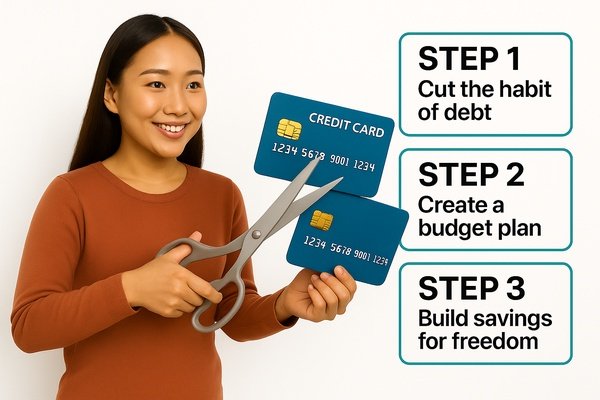Introduction: Why Credit and Debt Management Matters
In today’s economy, your financial health plays a bigger role than ever before. It impacts where you live, how you travel, whether you can retire comfortably, and what kind of opportunities you can give your family. At the heart of financial health are two essential skills: credit and debt management. These twin pillars affect everything from your ability to get a loan to the interest rates you pay and even the jobs you qualify for.
Many people think credit and debt are only relevant when they’re buying a house or applying for a credit card. In reality, these two areas impact your daily life more than you might realize. From renting an apartment, to signing up for a mobile phone plan, your credit score and how you manage your debt are key pieces of your financial identity. And yet, few people are ever formally taught how to manage them.
That’s where this article comes in.
Effective credit and debt management isn’t just about cutting up your credit cards or avoiding loans; it’s about using credit as a tool, staying ahead of your obligations, and making informed decisions that work for your goals. It’s about understanding how your credit score works, how debt grows, and how you can take control rather than being controlled by your financial obligations.
Most importantly, smart management empowers you to make confident financial decisions. When you know how credit and debt work, you stop reacting and start planning. You’re no longer at the mercy of interest rates or late fees. You begin to build a financial future that works for you, not against you.
In this guide, we’ll cover 10 smart credit and debt management tips that will not only help you stay out of trouble but also boost your financial standing over time. Whether you’re starting from scratch or digging out of a financial hole, each of these steps is designed to be practical, manageable, and results-driven.
So let’s jump into these strategies—because your financial freedom is worth the effort.
1. Credit and Debt Management: Know Your Credit Score and What Affects It
Your credit score is a snapshot of your financial trustworthiness. It’s a number that tells lenders how likely you are to repay debt. While many people ignore their credit score until it’s time to apply for a loan, the truth is that staying informed is key to long-term success.
There are several types of credit scores, but the most widely used is the FICO score, which ranges from 300 to 850. Here’s how it’s calculated:
- Payment History (35%): Do you pay your bills on time?
- Amounts Owed (30%): How much credit are you using compared to your limits?
- Length of Credit History (15%): How long have you had your accounts?
- New Credit (10%): Have you applied for credit recently?
- Credit Mix (10%): Do you have a mix of installment and revolving credit?
To improve your score, start by checking it regularly. Many banks and credit cards offer free FICO score access, and sites like Credit Karma or Experian provide free monitoring tools. Review your full credit reports annually at AnnualCreditReport.com to spot errors or suspicious activity.
Improving your credit score is an ongoing process, but even small changes like paying off a credit card or disputing an inaccurate report can lead to big results. A higher score opens doors to better interest rates, higher approval odds, and even lower insurance premiums.
Understanding your score is foundational. Once you know what affects it, you can start to make deliberate decisions that positively impact your financial life. That’s the essence of smart credit and debt management awareness leads to action.
2. Create a Monthly Budget That Supports Your Goals
A well-structured budget is one of the most powerful tools for credit and debt management. Without a budget, it’s easy to overspend, miss payments, or rely on credit to cover shortfalls. A budget isn’t about restriction, it’s about intention. It gives every dollar a job and helps you make choices that support your goals.
Start by calculating your net income, the amount you actually bring home after taxes. Then list all your fixed expenses (like rent, insurance, subscriptions) and your variable expenses (groceries, transportation, entertainment). Once you’ve tallied up the numbers, compare expenses to income.
If you’re spending more than you earn, it’s time to cut back. Look for areas where you can reduce without sacrificing your quality of life. Dining out, streaming services, or impulse purchases are often the easiest places to start.
One effective strategy is the 50/30/20 rule:
Use budgeting tools like YNAB, Mint, or EveryDollar, or go old-school with a spreadsheet. Set spending limits in each category and track your progress weekly.
The goal is progress, not perfection. Even if you slip up, reviewing your budget helps you stay aware. A good budget ensures your bills get paid, your savings grow, and your debt shrinks. And that’s what smart credit and debt management is all about.
3. Use Credit Cards Responsibly and Strategically
Credit cards aren’t inherently bad. In fact they can be excellent tools when used wisely. The key to success is using them strategically and never treating them like free money. Responsible credit card use is central to credit and debt management, because it directly impacts your credit score, your ability to borrow affordably, and your long-term financial flexibility.
The first rule of smart credit card use is simple but powerful: always pay on time. Even one late payment can stay on your credit report for up to seven years. Set up autopay for at least the minimum payment or use calendar reminders to keep you on track. Payment history is the single biggest factor in your credit score, and mastering it is foundational to successful credit and debt management.
Next, focus on your credit utilization ratio which is the percentage of available credit you’re using. Keep this below 30%, and ideally under 10%, for optimal impact on your score. For example, if you have a $10,000 credit limit, keeping your balance below $1,000 shows lenders you’re managing credit well. High utilization suggests financial stress, and it can drag down your score even if you pay on time.
Choose the right type of credit card for your goals. A cashback card is great for responsible everyday spending, while a travel rewards card benefits frequent flyers. If you’re rebuilding credit, consider a secured card. Just avoid chasing rewards if it causes you to spend more than you can afford. Overspending even on “good deals” can quickly undo your progress in credit and debt management.
Also, be cautious about opening multiple new accounts in a short period. Each application triggers a hard inquiry, which can temporarily lower your score. Plus, juggling too many cards can lead to confusion, missed payments, and higher risk of accumulating debt.
Avoid carrying high balances month to month. While paying the minimum may keep your account in good standing, the interest charges can snowball fast. If you do need to carry a balance temporarily, make a plan to pay it off quickly.
Used strategically, credit cards offer benefits like:
But used recklessly, they become traps that derail your financial progress. That’s why responsible usage must be a cornerstone of your credit and debt management plan. Every swipe should be intentional, every balance monitored, and every payment made on time.
In short, credit cards are powerful financial tools, but only in the hands of someone who understands how they fit into a larger credit and debt management strategy. Use them wisely, and they’ll work for you, not against you.
4. Build an Emergency Fund to Avoid Relying on Credit
One of the biggest causes of credit card debt is unexpected expenses. A car repair, medical bill, or job loss can derail even the best financial plan if you don’t have a safety net. That’s why building an emergency fund is essential to smart credit and debt management.
Think of an emergency fund as your personal insurance policy against debt. It’s not for vacations, new clothes, or birthdays, it’s for life’s surprises that hit hard and fast. When life throws a curveball, this fund helps you stay on your feet without reaching for high-interest credit cards or personal loans.
Your emergency fund should be separate from your regular checking account, ideally in a high-yield savings account. That way, it’s accessible, but not too easy to spend. The money should remain liquid, meaning it’s not tied up in investments that could lose value when you need cash the most. Liquidity is critical for proper credit and debt management, because the last thing you want during an emergency is to turn to debt that compounds rapidly.
Credit and debt management: How much should you save?
Start with a mini-goal of $500 to $1,000. That’s often enough to cover a car repair, urgent medical bill, or a last-minute flight. Once you’ve hit that, build toward 3 to 6 months’ worth of essential living expenses. This includes:
This kind of planning separates reactive spending from proactive financial security, and it’s a principle that lies at the core of credit and debt management.
Credit and debt management: Smart ways to grow your emergency fund:
And remember, every dollar counts. Even saving $10 a week adds up over time. The key is consistency. Consistent savings behavior not only boosts your resilience but reinforces good habits that support long-term credit and debt management goals.
Having this financial cushion offers more than just money, it provides peace of mind. You’ll sleep better knowing that a medical emergency or job layoff won’t lead to unmanageable credit card debt. It’s one of the most overlooked strategies in credit and debt management, yet one of the most powerful.
Without an emergency fund, even small setbacks can trigger a cycle of borrowing and compounding interest. With one, you’re not only prepared, you’re empowered. You stay in control during a crisis, make calm decisions under pressure, and keep your long-term financial goals intact.
This is what separates surviving from thriving. Building an emergency fund isn’t just smart, it’s the foundation of responsible credit and debt management in any season of life.
5. Credit and Debt Management: Pay More Than the Minimum on Debts
If you’re only making minimum payments on your credit cards or loans, you’re barely making a dent. Worse, you’re letting interest rack up and drag out your repayment timeline for years. Paying more than the minimum is a game-changer in effective credit and debt management.
Minimum payments are designed to benefit lenders, not you. For example, a $5,000 credit card balance at 20% APR could take over 15 years to pay off if you only pay the minimum, and you’ll end up paying more in interest than the original amount.
Instead, create a debt payoff plan using one of these methods:
Whichever method you choose, commit to it. Budget extra cash toward your priority debt each month. Even an extra $50 or $100 makes a huge difference.
Track your progress and celebrate small wins. As balances drop, your available credit increases, which improves your utilization ratio and boosts your credit score.
This habit builds momentum and confidence. It’s a clear sign you’re not just managing debt, you’re conquering it.
6. Credit and debt management: Avoid Unnecessary Debt and Buy Only What You Can Afford
One of the smartest things you can do for your financial health is avoid debt you don’t need. That might sound simple, but in a world of easy credit, buy-now-pay-later options, and flashy social media lifestyles, it’s easy to fall into the trap of overspending.
Here’s the truth: if you consistently spend more than you earn, you’re setting yourself up for a cycle of stress and financial instability. Credit and debt management begins with living within your means.
Before you swipe a credit card or take out a loan, ask yourself:
This isn’t about never enjoying life, it’s about doing it responsibly. That new TV, vacation, or luxury item might feel great in the moment, but if you’re paying interest on it for years, the cost is much higher than the price tag.
Practice delayed gratification. If you want something expensive, create a savings plan for it. The act of saving first builds discipline and protects your credit.
Also, avoid financing purchases that depreciate quickly, like high-end electronics or designer clothes. These items lose value fast, but the debt sticks around.
When you train yourself to buy only what you can afford, you build a foundation of financial control. It’s not about restriction, it’s about freedom from stress and smarter long-term choices.
7. Credit and debt management: Consolidate or Refinance High-Interest Debt
If you’re juggling multiple debts with high interest rates, you may feel like you’re constantly treading water. One smart way to regain control is through consolidation or refinancing, both powerful tools in modern credit and debt management.
Debt consolidation involves combining several debts, usually credit cards into one loan with a lower interest rate. This can simplify your finances by turning multiple payments into one, often with a lower monthly cost.
Refinancing replaces an existing loan (like a mortgage, car loan, or student loan) with a new one at better terms, usually a lower interest rate or longer repayment period.
Benefits of these options include:
However, these options only work if you change the habits that led to the debt. Don’t consolidate debt and then rack up new balances again. It’s like mopping the floor while the sink is still overflowing.
Before moving forward, compare interest rates, loan terms, and fees. Online calculators and financial advisors can help you determine if it’s the right move.
Used strategically, consolidation or refinancing can be a lifeline, not a crutch. It’s not a magic fix, but it can give you the breathing room you need to catch up and stay on track.
8. Monitor Your Accounts and Identity Regularly
Staying informed is a powerful form of protection. Monitoring your accounts and identity regularly is one of the most overlooked aspects of smart credit and debt management, but it’s one of the most crucial.
Why? Because identity theft and fraud are on the rise. If someone opens a credit card in your name or makes unauthorized charges, your credit score and financial future can suffer before you even notice. Ignoring this part of credit and debt management can leave you vulnerable to setbacks that take years to undo.
Set up alerts with your bank and credit card companies so you’re notified of:
These alerts form the frontline of defense in your personal credit and debt management strategy.
In addition to bank alerts, consider signing up for a free credit monitoring service like Credit Sesame or Credit Karma. These platforms notify you of changes to your credit report, such as new accounts opened or hard inquiries, helping you act quickly and prevent damage.
Also, pull your credit reports annually from all three major bureaus (Equifax, TransUnion, Experian) at AnnualCreditReport.com. Look for:
If you find errors, dispute them immediately. The sooner you act, the better the chances of correction without long-term impact on your score. Preventative action is a major pillar of effective credit and debt management.
You might also consider enrolling in identity theft protection services, especially if your information has been exposed in a data breach. These services offer credit freezing, dark web scans, identity recovery support, and more; giving you one more layer of confidence in your credit and debt management plan.
Staying vigilant helps you prevent fraud, correct errors, and maintain a strong financial position. In today’s digital world, your information is your currency. Protecting it is no longer optional. Make it a core habit in your ongoing approach to credit and debt management.
9. Don’t Co-Sign Loans Unless You’re Willing to Take Responsibility
Co-signing a loan might seem like a generous gesture, but it’s a high-risk move that can seriously impact your credit and debt standing. If someone asks you to co-sign, you’re not just vouching for them, you’re legally agreeing to pay if they can’t. And lenders will come after you first if things go south.
That’s why one of the smartest rules in credit and debt management is: Never co-sign unless you can and are willing to repay the loan in full.
Co-signing affects your:
Even if the borrower has the best intentions, life happens. They might lose their job, go through a divorce, or get sick. If they stop paying, you’re 100% responsible, and it can take years to repair the damage.
If you still choose to co-sign:
But in most cases, it’s smarter to help someone build credit in other ways. For example, you can add them as an authorized user on one of your credit cards (if you’re confident in their habits), or guide them to secured cards or credit-builder loans.
Protect your own financial future by saying no when necessary. Being generous is admirable, but not at the cost of your credit and peace of mind.
10. Credit and Debt Management: Seek Help When You Need It
Managing credit and debt isn’t always easy. And sometimes, despite your best efforts, things can spiral out of control. When that happens, the smartest thing you can do is ask for help. Seeking assistance is not a weakness, it’s a sign of strength, awareness, and smart credit and debt management.
There are many resources available to support you in your credit and debt management journey:
- Nonprofit credit counselors can help you create a budget, understand your credit report, and build a debt repayment plan. These professionals are trained to walk you through the most overwhelming parts of your finances and offer real, sustainable solutions.
- Debt management programs (DMPs) can help you consolidate your unsecured debts and negotiate lower interest rates, often with no loans involved. These structured plans can give you a predictable monthly payment while improving your standing with creditors.
- Financial therapists combine mental health and money support, helping people overcome shame, fear, or anxiety related to debt. Their guidance is especially helpful if emotional stress is interfering with your progress in credit and debt management.
Trusted organizations like the National Foundation for Credit Counseling (NFCC) and Money Management International (MMI) offer free or low-cost services to individuals across the U.S. These nonprofit groups are excellent starting points if you’re unsure where to begin your recovery journey.
But be cautious. Not all help is good help. Avoid debt relief companies that promise fast fixes, charge high upfront fees, or encourage you to stop paying creditors. These are red flags. Always check reviews, verify credentials, and understand the terms before signing anything. Responsible help is a crucial part of effective credit and debt management.
If you’re behind on payments, reach out to your lenders. Many offer hardship programs, deferment options, or modified repayment plans, especially if you show initiative. This kind of communication is a smart and underused tactic in credit and debt management.
Most importantly, don’t ignore the problem. Debt doesn’t disappear on its own, it grows. The longer you wait, the fewer options you may have. But the sooner you take action, the more empowered and in control you become.
You’ll be surprised how quickly momentum builds once you take that first brave step. And asking for help? That’s not a sign you failed, it’s a powerful move forward in your credit and debt management journey.
Final Thoughts: Credit and Debt Management: Take Charge of Your Financial Future
You now have 10 powerful, proven strategies for taking control of your financial life, but knowledge alone isn’t enough; action is where real change begins. When you implement even one of these smart credit and debt management tips, you begin reshaping your future for the better.
Credit and debt management is a journey. You might not get everything right the first time, and that’s okay. Progress is more important than perfection. Each payment made on time, each dollar added to savings, and each unnecessary purchase avoided is a win that builds momentum.
Let’s recap the mindset that will carry you forward:
If you’ve struggled with money in the past, remember, your past does not define your future. With the right systems, tools, and mindset, you can build a financial life full of freedom, not fear. And credit and debt management is at the center of that transformation.
Start small. Maybe today you pull your credit report. Tomorrow, you set up a budget. Next week, you open a savings account or cancel a subscription. Over time, these micro-decisions become macro-success and solidify your credit and debt management habits.
As you build better routines, you’ll notice something else: confidence. You’ll feel in control. You’ll sleep better. You’ll stop living paycheck to paycheck. And eventually, you’ll move from surviving to thriving, all because of consistent credit and debt management.
Your financial story is still being written. With smart credit and debt management, you’re not just keeping your head above water, you’re building a future that’s stable, secure, and full of opportunity.
The next step? Take one. Then take another. Before long, you won’t just be managing credit and debt, you’ll be mastering credit and debt management.
🚀 Ready to strengthen your financial foundation? Start applying these 10 powerful credit and debt management tips today to take control of your money and reduce financial stress.
But don’t stop here, level up your money skills by exploring our guide on personal finance basics everyone should know and learn how to build an emergency fund fast.







